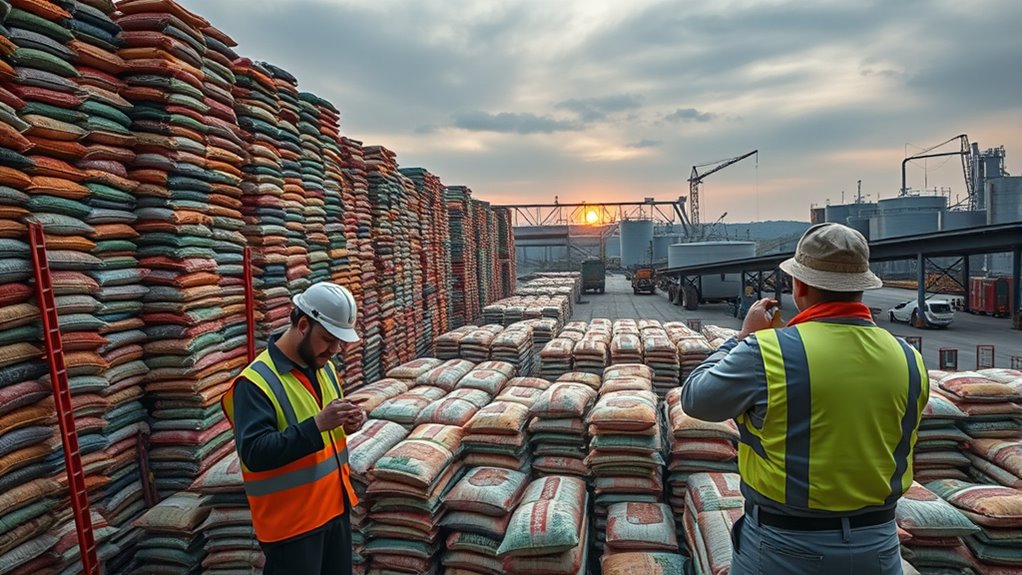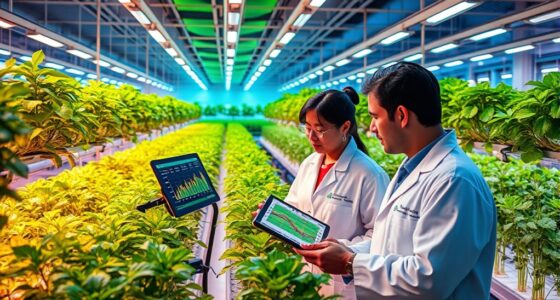The global fertilizer market is experiencing significant price swings and supply chain disruptions caused by fluctuating raw material costs, geopolitical tensions, and unpredictable weather patterns. These factors create volatility that affects affordability and availability. Technological innovations and sustainable practices are helping stabilize the market by improving supply management and reducing over-application. Staying informed about these trends and solutions can help you better navigate the ongoing challenges and opportunities in this dynamic market.
Key Takeaways
- Rising agricultural demands and technological progress drive increased fertilizer consumption globally.
- Price volatility stems from fluctuating raw material costs, geopolitical tensions, and weather patterns.
- Supply chain disruptions caused by conflicts and pandemics lead to shortages and market instability.
- Adoption of sustainable practices and digital tools enhances supply management and market stability.
- Innovation in manufacturing and real-time data sharing enable better adaptation to market fluctuations.

The global fertilizer market is experiencing significant shifts driven by rising agricultural demands and technological advancements. As you navigate this evolving landscape, you’ll notice that price volatility has become a key concern for producers and consumers alike. Factors like fluctuating raw material costs, geopolitical tensions, and unpredictable weather patterns contribute to sudden price swings, making it challenging to plan budgets and investments. Amid these uncertainties, adopting sustainable practices has become more vital than ever. Farmers and fertilizer companies are increasingly prioritizing environmentally friendly methods that reduce over-application and runoff, which can help stabilize prices over time. By integrating sustainable practices, you not only contribute to environmental health but also potentially mitigate some of the market’s inherent volatility, since efficient resource use tends to stabilize costs and supply.
Technological advancements play a vital role in shaping current market dynamics. Innovations such as precision agriculture, data analytics, and smart fertilizer application systems allow you to optimize crop yields while minimizing waste. These technological strides help in managing supply more effectively, reducing excess inventory, and improving forecasting accuracy. As a result, supply chain issues—such as delays in transportation, shortages of raw materials, or logistical bottlenecks—are being addressed more proactively. You’ll find that digital platforms and real-time data sharing enable better coordination among suppliers, distributors, and farmers, easing some of the strain caused by disruptions. Additionally, advances in manufacturing processes have led to the development of more efficient fertilizer products, which can be produced faster and with less environmental impact. This not only helps stabilize supply but also aligns with the increasing demand for sustainable solutions. Moreover, the integration of Bitcoin IRA and other innovative financial tools can provide new avenues for investment and risk management in volatile markets.
However, despite these technological improvements, supply chain issues persist due to external factors beyond your immediate control. Global events like conflicts, trade restrictions, and pandemic-related disruptions still impact the movement of fertilizers across borders. These challenges often cause sudden shortages or surges in prices, forcing you to adapt quickly. Staying informed about market trends, technological innovations, and sustainable practices enables you to better anticipate changes and implement strategies to manage risks. For example, diversifying supply sources or investing in local production can offer some resilience against international disruptions. Ultimately, the combination of embracing sustainable practices and leveraging technological advancements provides you with tools to navigate the price volatility and supply chain issues currently shaping the global fertilizer market.
Frequently Asked Questions
How Do Government Policies Influence Fertilizer Pricing Globally?
Government policies directly influence fertilizer pricing through policy shifts and subsidy effects. When policies change, they can make fertilizers more affordable or costly, impacting supply and demand. Subsidies lower production costs, encouraging farmers to buy more, which can stabilize prices. Conversely, removing or reducing subsidies often leads to price hikes. Your awareness of these policy impacts helps you understand how government decisions shape fertilizer affordability and market stability globally.
What Technological Innovations Are Shaping Future Fertilizer Production?
Ever wonder how future fertilizer production will evolve? You’ll see innovations like precision agriculture, which optimizes nutrient use and boosts efficiency, and nanotechnology advances that improve fertilizer delivery and absorption. These technologies make farming more sustainable and cost-effective. As you embrace these innovations, you’ll benefit from higher crop yields and reduced environmental impact, shaping a smarter, more resilient agricultural future. Are you ready to adopt these game-changing solutions?
How Do Seasonal Weather Patterns Impact Fertilizer Demand?
Seasonal weather patterns markedly influence fertilizer demand because climate variability affects crop planting schedules. When weather conditions are favorable, you’ll see an increase in fertilizer use to maximize yields. Conversely, unexpected weather events or irregular seasons can delay planting or reduce crop growth, decreasing fertilizer needs. By tracking these seasonal shifts, you can better plan fertilizer applications, ensuring ideal crop health and avoiding waste during unpredictable climate conditions.
What Are the Environmental Implications of Fertilizer Supply Chain Disruptions?
Supply chain disruptions can worsen environmental implications like increased runoff and habitat degradation. When fertilizer supplies are delayed or scarce, you might overapply or use suboptimal amounts, leading to more environmental runoff that contaminates water sources. This affects aquatic ecosystems and degrades habitats. Ensuring stable supply chains helps you manage fertilizer use more responsibly, reducing the risk of habitat degradation and protecting the environment from harmful runoff.
How Is the Rise of Organic Farming Affecting Fertilizer Markets?
Imagine a garden where organic certification is the sunlight nurturing healthy soil. As more farmers embrace organic farming, you notice fertilizer markets shifting—demand for synthetic fertilizers wanes, replaced by organic alternatives. This change encourages better soil health, reducing dependency on chemical inputs. You see a future where sustainable practices thrive, prompting fertilizer producers to innovate and adapt, aligning supply with the growing demand for eco-friendly farming methods.
Conclusion
You see, staying savvy in this shifting, sometimes shaky fertilizer market demands diligence and discernment. Price fluctuations and supply chain struggles can challenge your choices, but with careful planning and constant communication, you can conquer these concerns. Keep a keen eye on market movements, adapt swiftly, and stay a step ahead. By balancing bravery with flexibility, you’ll navigate this turbulent terrain successfully, turning today’s troubles into tomorrow’s triumphs.









